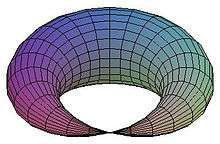Pseudomanifold
A pseudomanifold is a special type of topological space. It looks like a manifold at most of the points, but may contain singularities. For example, the cone of solutions of forms a pseudomanifold.

A pseudomanifold can be regarded as a combinatorial realisation of the general idea of a manifold with singularities. The concepts of orientability, orientation and degree of a mapping make sense for pseudomanifolds and moreover, within the combinatorial approach, pseudomanifolds form the natural domain of definition for these concepts.[1][2]
Definition
A topological space X endowed with a triangulation K is an n-dimensional pseudomanifold if the following conditions hold:[3]
- (pure) X = |K| is the union of all n-simplices.
- Every (n – 1)-simplex is a face of exactly two n-simplices for n > 1.
- For every pair of n-simplices σ and σ' in K, there is a sequence of n-simplices σ = σ0, σ1, …, σk = σ' such that the intersection σi ∩ σi+1 is an (n − 1)-simplex for all i.
Implications of the definition
- Condition 2 means that X is a non-branching simplicial complex.[4]
- Condition 3 means that X is a strongly connected simplicial complex.[4]
Related definitions
- A pseudomanifold is called normal if link of each simplex with codimension is a pseudomanifold.
Examples
- A pinched torus (see figure) is an example of an orientable, compact 2-dimensional pseudomanifold.[3]
- Complex algebraic varieties (even with singularities) are examples of pseudomanifolds.[4]
- Thom spaces of vector bundles over triangulable compact manifolds are examples of pseudomanifolds.[4]
- Triangulable, compact, connected, homology manifolds over Z are examples of pseudomanifolds.[4]
References
- ↑ Steifert, H.; Threlfall, W. (1980), Textbook of Topology, Academic Press Inc., ISBN 0-12-634850-2
- ↑ Spanier, H. (1966), Algebraic Topology, McGraw-Hill Education, ISBN 0-07-059883-5
- 1 2 Brasselet, J. P. (1996). "Intersection of Algebraic Cycles". Journal of Mathematical Sciences. Springer New York. 82 (5): 3625 − 3632. doi:10.1007/bf02362566.
- 1 2 3 4 5 D. V. Anosov. "Pseudo-manifold". Retrieved August 6, 2010.
This article is issued from Wikipedia - version of the 5/14/2016. The text is available under the Creative Commons Attribution/Share Alike but additional terms may apply for the media files.